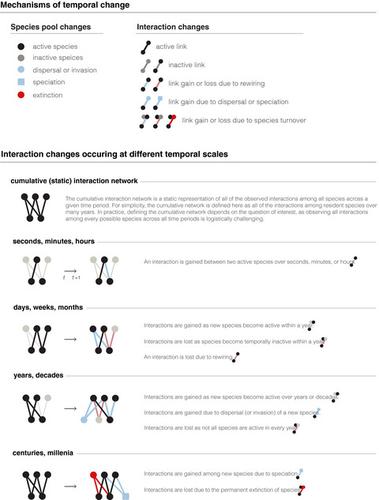当前位置:
X-MOL 学术
›
Ecol. Lett.
›
论文详情
Our official English website, www.x-mol.net, welcomes your
feedback! (Note: you will need to create a separate account there.)
Seeing through the static: the temporal dimension of plant–animal mutualistic interactions
Ecology Letters ( IF 7.6 ) Pub Date : 2020-10-19 , DOI: 10.1111/ele.13623 Paul J. CaraDonna 1, 2, 3 , Laura A. Burkle 4 , Benjamin Schwarz 5 , Julian Resasco 6 , Tiffany M. Knight 7, 8, 9 , Gita Benadi 5 , Nico Blüthgen 10 , Carsten F. Dormann 5, 11 , Qiang Fang 12 , Jochen Fründ 5 , Benoit Gauzens 9, 13 , Christopher N. Kaiser‐Bunbury 14 , Rachael Winfree 15 , Diego P. Vázquez 11, 16, 17
Ecology Letters ( IF 7.6 ) Pub Date : 2020-10-19 , DOI: 10.1111/ele.13623 Paul J. CaraDonna 1, 2, 3 , Laura A. Burkle 4 , Benjamin Schwarz 5 , Julian Resasco 6 , Tiffany M. Knight 7, 8, 9 , Gita Benadi 5 , Nico Blüthgen 10 , Carsten F. Dormann 5, 11 , Qiang Fang 12 , Jochen Fründ 5 , Benoit Gauzens 9, 13 , Christopher N. Kaiser‐Bunbury 14 , Rachael Winfree 15 , Diego P. Vázquez 11, 16, 17
Affiliation

|
Most studies of plant–animal mutualistic networks have come from a temporally static perspective. This approach has revealed general patterns in network structure, but limits our ability to understand the ecological and evolutionary processes that shape these networks and to predict the consequences of natural and human‐driven disturbance on species interactions. We review the growing literature on temporal dynamics of plant–animal mutualistic networks including pollination, seed dispersal and ant defence mutualisms. We then discuss potential mechanisms underlying such variation in interactions, ranging from behavioural and physiological processes at the finest temporal scales to ecological and evolutionary processes at the broadest. We find that at the finest temporal scales (days, weeks, months) mutualistic interactions are highly dynamic, with considerable variation in network structure. At intermediate scales (years, decades), networks still exhibit high levels of temporal variation, but such variation appears to influence network properties only weakly. At the broadest temporal scales (many decades, centuries and beyond), continued shifts in interactions appear to reshape network structure, leading to dramatic community changes, including loss of species and function. Our review highlights the importance of considering the temporal dimension for understanding the ecology and evolution of complex webs of mutualistic interactions.
中文翻译:

透视静态:植物与动物相互影响的时间维度
大多数植物-动物互惠网络的研究都是从时间静态角度出发的。这种方法揭示了网络结构的一般模式,但是限制了我们了解影响这些网络的生态和进化过程以及预测自然和人为干扰对物种相互作用的影响的能力。我们回顾了有关动植物互动网络(包括授粉,种子传播和蚂蚁防御共生)的时间动态的文献。然后,我们讨论了这种交互作用背后的潜在机制,范围从最佳时间尺度的行为和生理过程到最广泛的生态和进化过程。我们发现,在最佳的时间尺度(天,周,月),相互影响是高度动态的,网络结构变化很大。在中等规模(数年,数十年),网络仍然表现出高水平的时间变化,但是这种变化似乎对网络特性的影响很小。在最广泛的时间尺度上(数十年,几个世纪甚至更远),相互作用的不断变化似乎重塑了网络结构,导致了剧烈的社区变化,包括物种和功能的丧失。我们的评论强调了考虑时间维度对于理解相互影响的复杂网络的生态和演化的重要性。在最广泛的时间尺度上(数十年,几个世纪甚至更远),相互作用的不断变化似乎重塑了网络结构,导致了剧烈的社区变化,包括物种和功能的丧失。我们的评论强调了考虑时间维度对于理解相互影响的复杂网络的生态和演化的重要性。在最广泛的时间尺度上(数十年,几个世纪甚至更远),相互作用的不断变化似乎重塑了网络结构,导致了剧烈的社区变化,包括物种和功能的丧失。我们的评论强调了考虑时间维度对于理解相互影响的复杂网络的生态和演化的重要性。
更新日期:2020-12-12
中文翻译:

透视静态:植物与动物相互影响的时间维度
大多数植物-动物互惠网络的研究都是从时间静态角度出发的。这种方法揭示了网络结构的一般模式,但是限制了我们了解影响这些网络的生态和进化过程以及预测自然和人为干扰对物种相互作用的影响的能力。我们回顾了有关动植物互动网络(包括授粉,种子传播和蚂蚁防御共生)的时间动态的文献。然后,我们讨论了这种交互作用背后的潜在机制,范围从最佳时间尺度的行为和生理过程到最广泛的生态和进化过程。我们发现,在最佳的时间尺度(天,周,月),相互影响是高度动态的,网络结构变化很大。在中等规模(数年,数十年),网络仍然表现出高水平的时间变化,但是这种变化似乎对网络特性的影响很小。在最广泛的时间尺度上(数十年,几个世纪甚至更远),相互作用的不断变化似乎重塑了网络结构,导致了剧烈的社区变化,包括物种和功能的丧失。我们的评论强调了考虑时间维度对于理解相互影响的复杂网络的生态和演化的重要性。在最广泛的时间尺度上(数十年,几个世纪甚至更远),相互作用的不断变化似乎重塑了网络结构,导致了剧烈的社区变化,包括物种和功能的丧失。我们的评论强调了考虑时间维度对于理解相互影响的复杂网络的生态和演化的重要性。在最广泛的时间尺度上(数十年,几个世纪甚至更远),相互作用的不断变化似乎重塑了网络结构,导致了剧烈的社区变化,包括物种和功能的丧失。我们的评论强调了考虑时间维度对于理解相互影响的复杂网络的生态和演化的重要性。











































 京公网安备 11010802027423号
京公网安备 11010802027423号